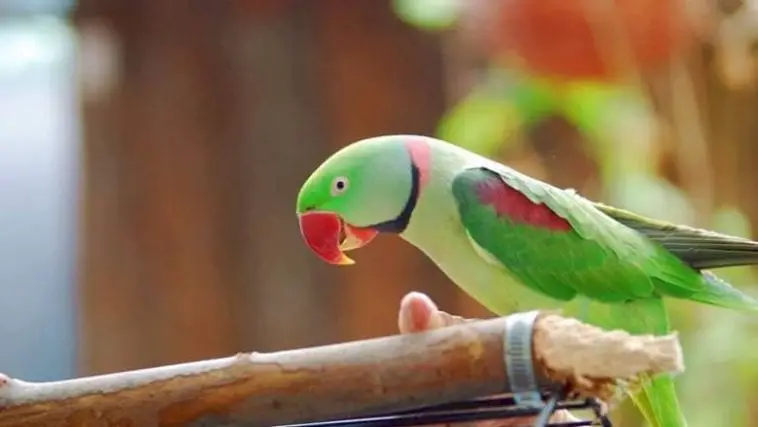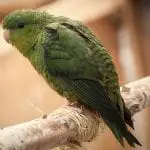Scientific Facts
| Common Name | Alexandrine Parakeet |
| Scientific Name | Psittacula eupatria |
| Lifespan | 25 – 30 Years |
| Size | 22.6 inches (58 cm) |
| Mass | 8.75 – 9.1oz. (250 – 260 grams) |
| Habitat | Woodland, cultivated areas, city parks, moist and dry forests |
| Distribution | Central Asia, India |
Information & Physical Appearance
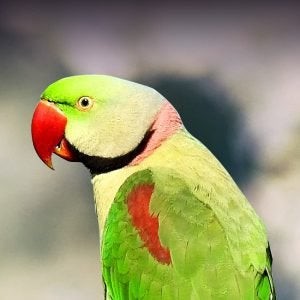
The Alexandrine Parakeet (Psittacula eupatria) is also commonly known as Greater Rose-ringed Parakeet, Large Parakeet, Alexandrine Ring-necked Parakeet, Large Indian Parakeet, Large Ceylonese Parakeet, Large Andaman Parakeet, Large Burmese Parakeet, Great-billed Parakeet, and Thai Rose-ringed Parakeet.
There are five races of Alexandrine parakeets, including the nominate race.
1. P.e. eupatria – Nominate Alexandrine parakeet
This is one of the largest parakeets in the world. Adults measure between 22 – 24 inches in length from the tip of the tail to the top of the head, with the tail itself accounting for around 1/1 of the total body length, reaching up to 14 inches long.
They attain an average body mass of 7.1 to 10.6 oz.
The plumage is predominantly green. On the back of the neck, as well as on the cheeks, a light blue-grey sheen is noticeable.
The abdomen is yellow-green. There is a red patch on the shoulders. The massive beak is red in color, with yellow tips.
The tail is yellow at the tip, passing through blue nuances further up, with the upper-side being green at the very top. Meanwhile, the tail is yellow on the underside.
Adult Alexandrines are sexually dimorphic, and it is easy to tell males apart from females since males are “equipped” with a pink band on their nape, as well as a black stripe that crosses their lower cheeks. The pink band and the black stripe are lacking in adult females, and they are generally duller than males.
Young Alexandrines pretty much resemble mature females, but their tails are shorter. Also, their eyes are grey.
2. P.e. nipalensis – Large Indian parakeet
Just as its name suggests, the Larger Indian parakeet is bigger in size than the nominate Alexandrine parakeet. Also, both sexes are more greyish-green in color.
The cheeks, as well as the head, display washed blue patches. The black stripe that runs across the lower cheeks of adult males is broader.
3. P.e. magnirostris – Large Andaman parakeet
The Large Andaman parakeet is only slightly larger than the nominate Alexandrine parakeet. The shoulder patch is visibly brighter in color, and the beak is larger in size, and nonetheless, heavier.
Just above the nape band (the pink collar), adult males possess a narrow, thin blue stripe. There is a brighter red spot on the wing.
Females resemble the nominate subspecies females, but their bill is larger.
Juveniles’ plumage is the same as seen in the Nominate Alexandrine parakeets, with the major difference that their bill is heavier and larger.
4. P.e. avensis – Large Burmese parakeet
When compared with the nominate subspecies, the Large Burmese Parakeet has a smaller-sized bill.
Adult males look just like Large Indian Parakeet males. However, with Large Burmese parakeets, the underparts, as well as the neck, are more yellowish in color. Also, on the hindneck, a thin, narrow blue stripe can be noticed, yet occasionally, it may be absent.
Adult female Large Burmese parakeets are quite similar to adult female Large Indian parakeets, with a smaller bill, though.
5. P.e. siamensis – Thai rose-ringed parakeet
Thai rose-ringed parakeets are smaller in size than the nominate subspecies.
In addition to that, the Thai rose-ringed parakeets’ shoulder patch is paler. The neck and the face are yellowish.
Adult males resemble adult male Large Burmese parakeets, with the major difference that the nape and the back of the head are both suffused with blue. Also, the spot on the wing is redder in color.
Adult females are fairly similar to adult female Large Burmese parakeets, with the only exception that their neck and face are yellowish.
Lifespan
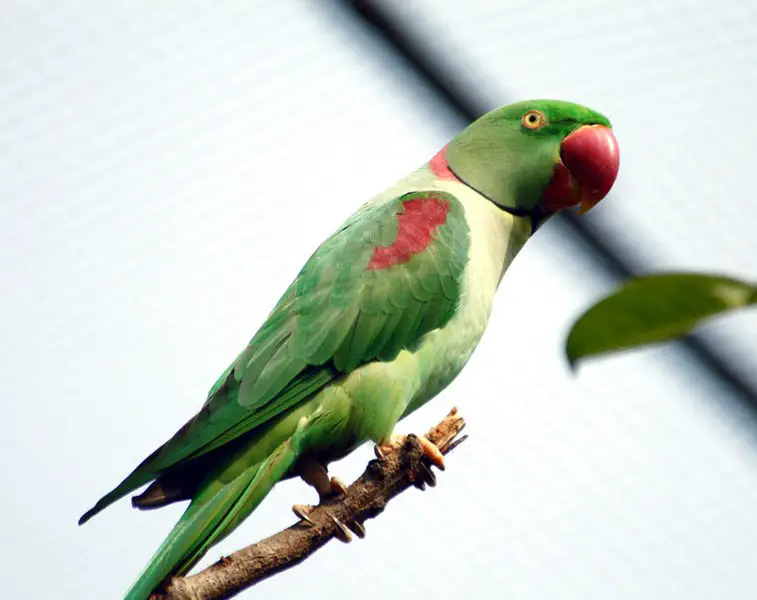
Alexandrine parakeets are known to live for up to 25 – 30 years when raised in captivity with proper care. Also, there are recorded cases of Alexandrine parakeets living up to 40 years of age.
The generation length is estimated at 7.6 years.
Ecosystem & Habitat
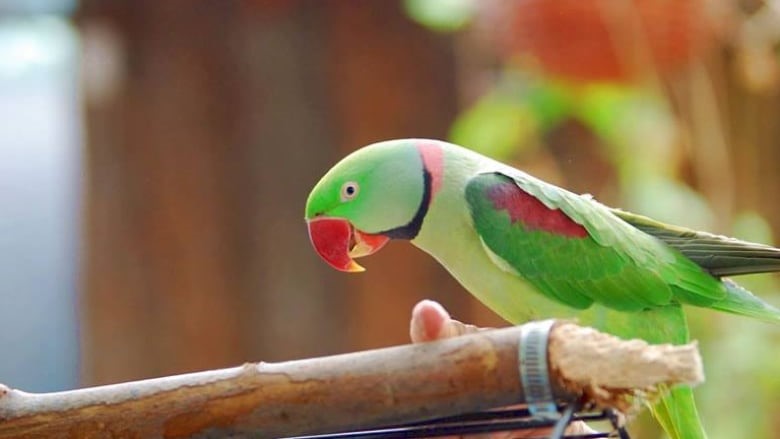
Habitat
Alexandrine Parakeets are found in a wide variety of habitats. These include cultivated areas, jungles, woodland, moist, and dry forests.
Typically, these birds form small flocks. However, provided that food is abundant, they are known to form bigger groups.
Also, bigger groups are formed at communal roosts. It is at communal roosts where birds from a big area may choose to gather together, collectively sharing one large-sized tree.
Because of their coloration, Alexandrine parakeets tend to be quite difficult to see in the wild, as they perfectly blend in when sitting in the trees.
Apart from their native habitats in the wild, this bird species has managed to naturalize itself in a big number of European countries. More specifically, feral populations of Alexandrine parakeets are well-established in Belgium, western Turkey, in the southern portions of England, Germany, and the Netherlands.
Due to the feral hybrid populations established in many different cities across the globe by released and escaped captive birds, this species is considered the most northerly of all wild parrots.
Alexandrine parakeets have proved to be highly adaptable, as they have successfully adjusted to rather cooler climates, e.g., the climate in Amsterdam and London, where large flocks of these amazing feathery fellows can be seen in the local parks.
Psittacula eupatria species are found at elevations of up to 2952ft.
Range
P.e. eupatria (Nominate Alexandrine parakeet) is found in the Indian peninsula (western and south India), and Sri Lanka.
P.e. nipalensis (Large Indian parakeet) is distributed in Assam and Bhutan to Bangladesh, in eastern and south Pakistan, Nepal to Central India, and North India.
P.e. magnirostris (Large Andaman parakeet) occurs nearby Coco Islands, the Bay of Bengal, as well as in the Andaman Islands.
P.e. avensis (Large Burmese parakeet) is found in Bangladesh, Myanmar, and Northeast India.
P.e. siamensis (Thai rose-ringed parakeet) is native to Central Laos (very rarely found in north Laos), Vietnam, northern and western Thailand to Cambodia.
Food & Diet
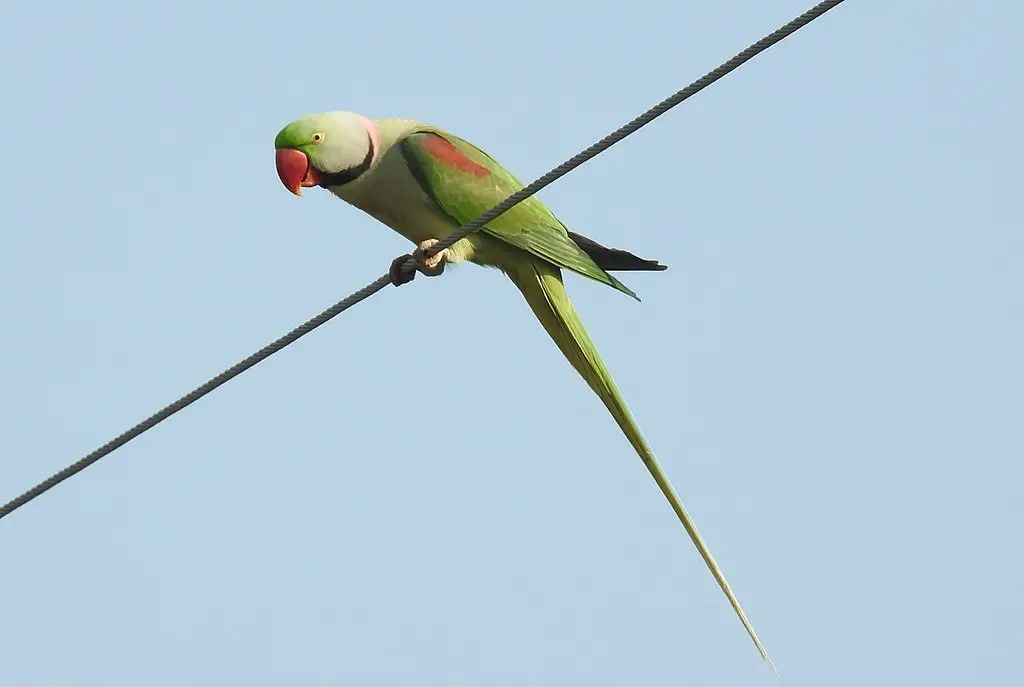
Alexandrine Parakeets are omnivorous birds. They will gladly eat almost any type of food.
Alexandrine parakeets can be often seen on the ground, where they search for fruit, seeds, and insects.
A huge portion of these birds’ diet consists of an array of cultivated and wild seeds, as well as buds, nectar, flowers, fruit, vegetables, and nonetheless, grain.
Unfortunately, as Alexandrine parakeets form large flocks in areas where food is abundant, these birds are known to often have a serious, negative impact on a field making, and hence, they are not well-tolerated, and in fact, they are disliked, by farmers.
More specifically, the large feeding flocks of Alexandrine parakeets are unwanted visitors by farmers since they can cause extensive damage to grain crops, such as jowar and maize, as well as to crops of ripening fruits.
Behavior
Alexandrine parakeets are known for their generally loud, harsh call. The call is described as a loud, scolding, deep, and, ultimately, ringing sound.
The variety of calls includes a deep 4x “klak” note, a ringing “trrrieuw” note, a resonant “gr-aak” note, and a rather loud “keeak” or “kree-aar” note.
As compared with the calls of its close relative, the rose-ringed parakeet, the Alexandrine parakeet’s call is typically more resonant, harsher, and deeper.
Also, when mobbing predators, these parakeets will shriek quite loudly, with their voices becoming much harsher when alarmed.
Interestingly, flocks are known to occasionally vocalize together excitedly. In captivity, Alexandrine parakeets will often imitate human speech.
These birds usually live in small flocks. At communal roosts, as well as in areas with a high abundance of food, they are to form significantly bigger flocks.
Reproduction
Depending on location, the breeding season for Alexandrine parakeets begins in early November throughout December, or from early March throughout April. More specifically, in their native range, these birds breed from November to April.
Usually, Alexandrine parakeets nest in readily available tree hollows. However, they may sometimes choose to use cracks in buildings or tree holes that they have excavated themselves.
Females are to lay between 2 and up to 4 eggs per clutch. The eggs are broad, blunt, oval, and measure 1.1 – 1.3 inches.
On average, the incubation period lasts for 24 days.
It takes approximately 7 weeks for the chicks to fledge. However, the young chicks will continue being dependent on their parents until they are to finally turn 3-4 months of age.
Survival Threats & Conservation
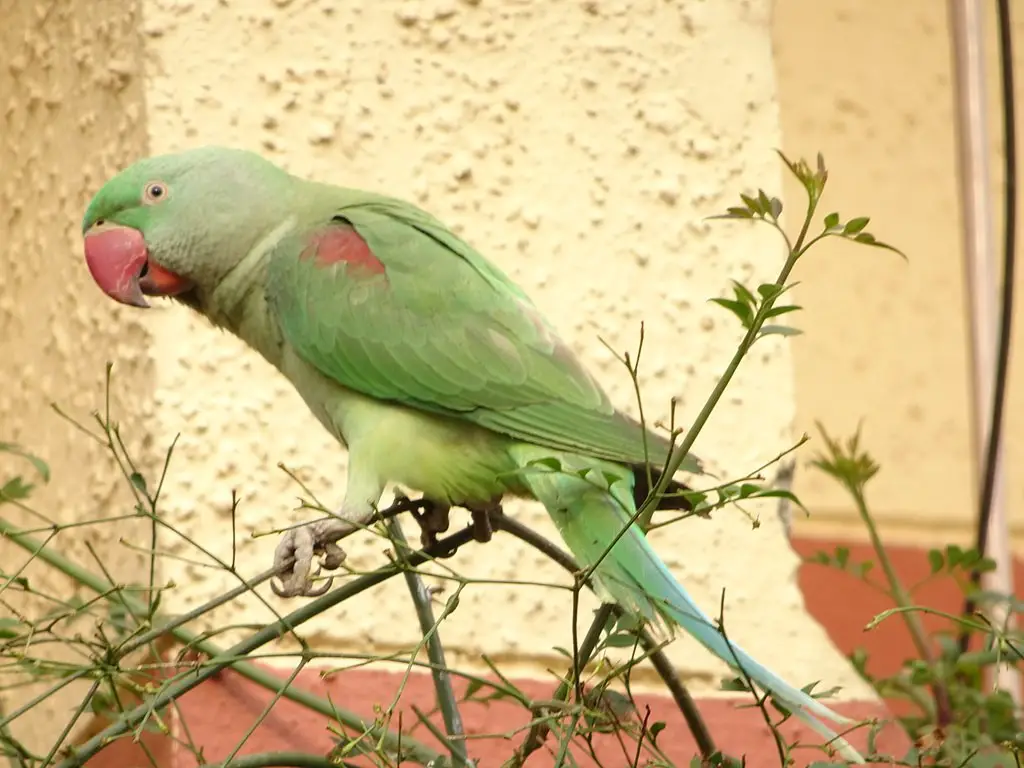
Alexandrine Parakeets are critically endangered with extinction in Pakistan, and particularly in Punjab province. That’s majorly due to habitat loss related to the progressive cutting of old trees, as well as the excessive poaching of the wild Alexandrine parakeet chicks.
Sadly, even though the sale of these exotic birds as pets is officially banned in Pakistan, they can still be found widely available, openly sold in broad daylight in the local urban markets of Rawalpindi and Lahore. This suggests that the Indian government keeps failing to provide sufficient resources towards the preservation and protection of this incredible species.
Ultimately, this species’ wild population has been undergoing a drastic decline in recent years, mostly because of the trapping pressure occurring based on the high demands of the global pet trade.
Apart from habitat destruction and collection for the pet trade, the heavy use of pesticides has also greatly contributed to the diminishing of the presence of Alexandrine parakeets in the wild.
Up-to-date, Alexandrine parakeets remain some of the most sought-after cage birds available for sale in the Indian market. Furthermore, according to trade data shared by CITES, a minimum of 57 772 of these parakeets were imported outside their native range within the course of about 30 years, more specifically, in the period between 1981 and 2014.
Alexandrine parakeets are listed as Near Threatened on the IUCN Red List of Threatened Species. The population trend is decreasing, based on the 2016 global assessment.
Even though conservation sites are identified over the entire range, there is no action recovery plan running, and there is no systematic monitoring scheme for this species.
Availability – Where to Get an Alexandrine Parakeet
For those who wish to acquire an Alexandrine parakeet, the best way to get this bird is to contact reputable bird breeders or visit avian-specialty stores.
While the Nominate Alexandrine parakeet has an immense beak and plumage that is fully green, there are many color mutations one can choose from. Color morphs keep becoming more widely available to consumers because of the high demand. Some of the most sought-after color mutations include the blue mutations, as well as the yellow (lutino) mutations.
Not the least, when getting an Alexandrine parakeet to take care of as a pet, owners-to-be can choose from five distinct subspecies, keeping in mind that some are slightly smaller, or respectively, slightly larger than others.
Interesting Facts
1. It was all the way back to around 350 years BC when Alexander the Great (the King of Ancient Greece) went off traveling across the globe, conquering different parts all over the world. When he returned to Europe, he brought many different “souvenirs” back home, including Alexandrine parakeets.
Alexander the Great exported big numbers of Alexandrine parakeets to various Mediterranean and European countries from Punjab, India. Thus, this exotic bird species was named after him.
It didn’t take long before these parakeets’ ability to mimic human speech made them extremely popular as pets in many European homes, which happened hundreds of years prior to the birth of Jesus Christ.
2. It was in August 2016 when Perroquetes en folie’s sociable star – Paco, the Alexandrine parakeet – got stolen. Actually, it was the second time he has been stolen within the course of five years.
Then the St-Placide parrot zoo and refuge, located about 70 kilometers west of Montreal, Canada, told the thief of the parrot to bring Paco home as soon as possible, or else, police will be called. The message was posted on Facebook, and it soon went viral.
Furthermore, Breton shared that ever since having been stolen for the first time five years ago, Paco has been making a beeping sound, just like an alarm system. It was thanks to this sound that people in the area where the stolen parrot was being kept managed to hear it and called the police to notify them about the unusual sounds.
Most probably, the stolen parrot had been kept close by an alarm system, and this is what actually led to this awkward, unique alarm-like sound he has been making ever since.
In the viral Facebook post asking the thief to return the parrot immediately, Perroquetes en folie highlighted that parrots greatly suffer from a change in their environment, and further stated that according to some people, these parakeets are “objects,” yet they are not, and can be “traumatized and feel fear.”
3. The first person to describe the Alexandrine parakeet was the French zoologist Mathurin Jacques Brisson. He described this bird species in 1760 as Psittaca Ginginiana or The Gingi’s Parakeet (“La Perruche de Gingi”).
It was named after a town in southeastern India, namely the town of Gingee, which used to be a French outpost back then, although it is suggested that the birds may have merely been kept in captivity there.
Only several years later, in 1766, Carl Linnaeus re-described this amazing bird species under its current binomial name Psittacus eupatria.
The genus name (Psittacula) is derived from Latin, and is a diminutive of the word “psuttacus,” which translates into “parrot.” The specific name “eupatria” is of ancient Greek origin, and is derived from the words “eu” (meaning “well”), and “patria” (meaning “descent”).
4. During the middle of the 2nd century BCE, a Hellenistic mosaic floor panel depicting an Alexandrine parakeet was made in the acropolis of Pergamon. Currently, the acropolis of Pergamon is located close to modern Bergama, Turkey.
How to Care for the Alexandrine Parakeet
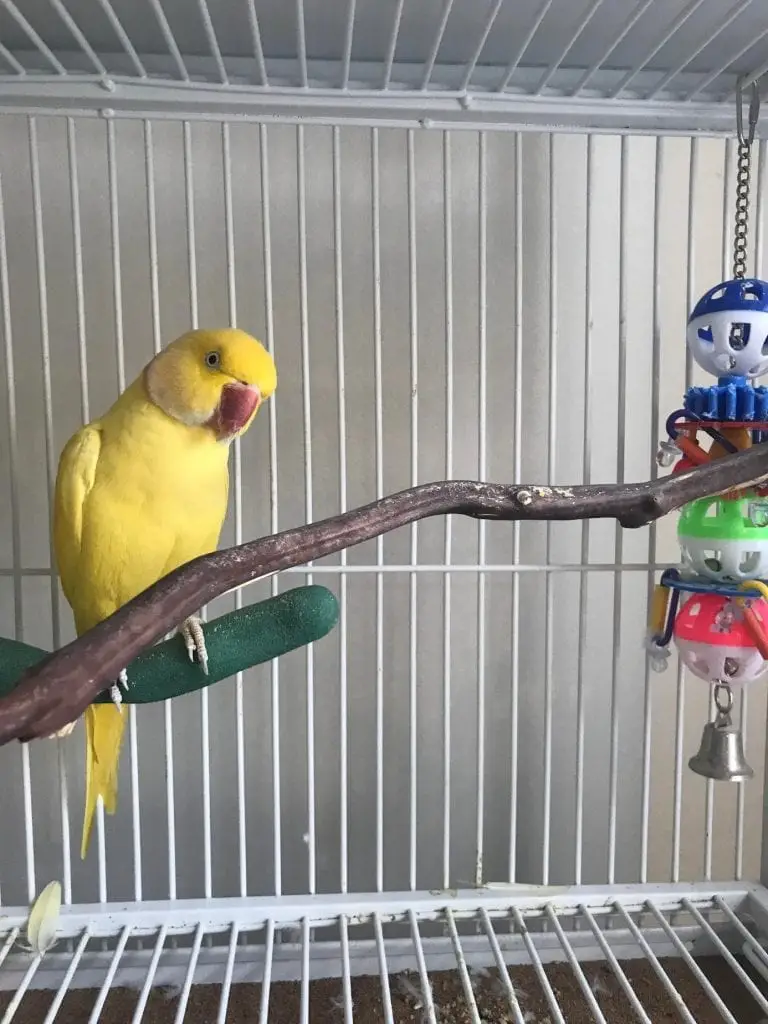
For bird lovers who want to take care of a playful, loyal, and talkative feathery companion, the Alexandrine parakeet can make a fantastic choice. These entertaining, active, social birds are capable of learning a lot of tricks and are inclined to show off their amusing, impressive acrobatic skills at every suitable occasion.
1. Housing & Cohabitation
Alexandrine parakeets have rather long tail feathers, which can reach up to 14 inches in total length. With this in mind, it is especially important to provide a cage that is tall enough to accommodate them.
Make sure to opt for a cage featuring welded mesh construction and/or metal, since wood is fairly easily destroyed by these parakeets’ powerful, large beaks.
Ideally, a walk-in aviary will work excellent. The minimum length of the aviary should be 14ft.
When it comes to cohabitating Alexandrine parakeets, it is good to note that these birds will generally live peacefully when introduced to the company of other birds of their kind. However, Alexandrine parakeets often tend to be aggressive toward other birds.
As a rule of thumb, keep smaller birds out of the reach of an Alexandrine parakeet, since its large, strong beak can cause serious damage.
In case you already have a ringneck parakeet, it is fine to let them play with Alexandrine parakeets without being worried about possible issues related to aggression. However, do not let these two species breed.
2. Cage Enrichment & Accessories
Similarly to most parrots, Alexandrine parakeets are chewing machines. They do require plenty of softwood toys to keep them satisfied and happy.
In addition to bird-safe chewable toys, provide a few indestructible acrylic toys, as well as a few ropes. That’s all you need to get your Alexandrine parakeet, all ready to play!
Also, puzzle toys (the ones hiding dried fruits or nuts) can be exceptionally entertaining for the Alexandrine parakeet pet. Remember that this bird is always in the mood for a challenge!
Pine cones, swings, ladders, foot toys, vegetable-tanned leather toys, bathing toys, and nonetheless, push-and-pull toys, are also highly recommendable.
3. Sound & Speech
Alexandrine parakeets are known for their excellent mimicking abilities. They are capable of copying just about any sound!
Mind that as compared with its close cousin (the ring-necked parakeet), the Alexandrine parakeet emits a deeper and nonetheless powerful screech.
4. Temperament & Personality
The Alexandrine parakeet can be quite a talkative pet capable of amassing a truly impressive vocabulary. It is also very playful.
This bird is also highly favored as it makes an excellent family pet, because of being able to bond to multiple family members, instead of strictly to one person, like other species typically do.
Apart from having a solid reputation as capable acrobats, these birds can also learn tricks fairly quickly.
Both the experienced, as well as the novice bird keepers can enjoy taking care of the Alexandrine; however, it is important to note that this bird may not make the best choice for the very beginner. Anyway, those who have kept a parakeet, or other similar bird, may actually be ready to acquire the easy-going Alexandrine and keep it healthy and happy without much of a fuss.
Note that Alexandrines may be nippy, yet regardless of their huge-sized beak, they are known as extremely affectionate, as long as they are given consistent attention and proper care.
Ultimately, remember that the Alexandrine parakeet is capable of loving its human “flock” very deeply, and is highly affectionate, so this bird needs a caregiver who is able to provide a good deal of time spent out of the cage, engaged in various activities.
5. Cleaning & Maintenance
Clean food and water containers every single day by thoroughly washing them with hot, soapy water, allowing them to dry, and then refilling them.
Cage accessories and toys should be thoroughly cleaned every single week (at least once.)
The entire cage, including enrichments, should be carefully disinfected at least once a month.
Do not let uneaten food hang in the cage for too long, and always make sure to clean feces as soon as feasible.
6. Common Health Issues
As a rule of thumb, Alexandrines are known as relatively healthy, hardy birds to keep as pets.
However, some of the most common health issues they are susceptible to include bacterial infections, psittacosis, Polyomavirus, and aspergillosis.
7. Captive Diet and Feeding
Fruits should form about 30% of this bird’s diet. Some of the suitable fruits to offer include banana, cactus fruits, apples, mangoes, pears, oranges, and pomegranates, among others.
The rest of the diet should consist of limited mixed seeds, spray millet, complete kibble, cooked, as well as sprouted pulses and beans, and, nonetheless, fresh veggies, such as celery, green peas, carrot, green leaves, and fresh corn.
8. Breeding
For experienced bird caregivers who wish to breed their Alexandrine parakeets, a suitable nest box should be provided. Opt for a vertical box measuring 12″ x 12″ x 18″.
Expect 2-4 eggs to be laid, keeping in mind that the female will be incubating the eggs for a period of about 24 – 27 days.
If the babies are removed within about 10 days after hatching, and then hand-fed, breeders can easily acquire not a single one but two clutches of chicks.
FAQs
How to Tell the Age of an Alexandrine Parakeet?
It tends to be quite difficult to tell the exact age of an Alexandrine Parakeet by merely looking at it. However, it may be useful to keep in mind that adult feathering is typically acquired between 18 and up to 30 months of age, although sometimes, it may show as old as a full 36 months of age, or as young as 12 months of age.
What Do Alexandrine Parakeets Eat?
Alexandrine parakeets basically eat just about anything a human eats, except for sugary candies, alcohol, avocado, and chocolate, which are toxic to birds. A healthy diet should consist of pellets and seeds as a base, accompanied by about 30% of fresh fruits and veggies.
Can Alexandrine Parrots Eat Bananas?
Yes, Alexandrine parrots can eat bananas, although some individuals may actually refuse to do so based on their personal preferences. Try offering bananas, and if not accepted, try offering other fruits to find out what your Alexandrine prefers.
Can Alexandrine Parakeets Eat Oranges?
Yes, fruits are needed for a balanced and complete diet, and Alexandrine parakeets can eat oranges, among just about any kind of fruit, including but not limited to melons, currant, berries, tangerines, and grapefruits, to name a few.
Can Alexandrine Parakeets Eat Strawberries?
Alexandrine parakeets can eat strawberries. Fruits make an essential component of these birds’ diet, and apart from strawberries, caregivers should also include citrus fruits, dried fruits, such as figs and raisings, as well as plums and apricots, among others.
Can Alexandrine Parakeets Eat Celery?
Yes, Alexandrine parakeets can eat celery as part of the vegetable menu in their diet, including other fresh veggies, such as beans, lettuce, alfalfa sprouts, bean sprouts, sweet corn, peas, and silverbeet spinach. Make sure to lightly steam or break down veggies high in cellulose in order to make them more digestible, e.g., carrot, sweet potato, pumpkin, Brussels sprouts, and broccoli, among other deep orange or green vegetables.
Can Alexandrine Parrots Eat Meat?
It is fine to let Alexandrine parrots eat meat, although only occasionally. Give them only a small amount of thoroughly cooked meat to cater to their protein requirements, for instance, tuna and salmon (water-packed or canned), and limit any dairy products to an extra tiny amount as to provide the birds with additional calcium without causing health issues related with their intolerance to lactose.
How Many Eggs Do Alexandrine Parrots Lay?
Female Alexandrine parakeets will lay between two and four eggs per clutch.
Is the Alexandrine Parakeet Banned in India?
The blanket ban on the Alexandrine parakeet trade was introduced ever since 1990/1991 in India. Regardless, a captive parrot remains one of the most visible symbols of the illegal bird trade in India up-to-date, where hundreds of parakeets are illegally collected from their natural habitat in the wild annually.
How Much Does an Alexandrine Parakeet Cost?
An Alexandrine parakeet can cost from $200 to about $600 on average. Mind that apart from purchasing a healthy, captive-bred Alexandrine parakeet, you will also need a sturdy, large cage, as well as plenty of toys and other cage accessories to keep the parrot happy.
Are Alexandrine Parakeets Aggressive?
Alexandrine parakeets are rarely known to become aggressive and are not the “bully” type, but instead, they are highly cherished as pets because of their very calm, gentle, outgoing, social, playful, loyal, peaceful personality. In fact, despite their large, intimidating beak, Alexandrines may be easily scared off by more aggressive birds, even if the latter is much smaller in size!
How Long Do Alexandrine Parakeets Live for?
When properly cared for, captive Alexandrine parakeets can easily live for about 25 – 30 years. With the utmost care and attention, they can even live for up to 40 years of age.
Are Alexandrine Parakeets Loud Pets?
In general, the Alexandrine parakeet is not considered an extremely loud, especially noisy type of parrot. However, Alexandrine can be loud if they wish to, and this is most often the case in the afternoon and in the morning.
How to Tell the Difference Between a Male and a Female Alexandrine Parakeet?
As a rule of thumb, Alexandrine parakeets are sexually dimorphic, so it is easy to tell the difference between a mature male and a mature female Alexandrine. Mature males possess a black stripe that runs across their lower chicks, and a band in pink color on their nape, while mature females do not have a black stripe, and neither do they have a pink band.
Do Alexandrine Parakeets Make Good Pets?
Alexandrine parakeets are widely regarded as some of the best family pets, but it is good to note that they can be noisy (though not as noisy as the ringneck parakeet). They are good talkers, enjoy playing with multiple family members, and are not nippy in general, yet are very affectionate, even though not as cuddly as other parrots.
What is the Difference between an Alexandrine and a Ringneck Parakeet?
The Ringneck parakeet (including the African and the Indian subspecies) is a smaller version of the Alexandrine parakeet. The Alexandrine parakeet has a long tail, dark green body, yellow eyes, and a red beak, and the major difference from the Ringneck parakeet is the larger bill and the patched wings.
How to Take Care of an Alexandrine Parakeet?
To take proper care of an Alexandrine parakeet, owners want to devote a great deal of their time engaged in playing with their pets. Provide lots of softwood toys and a few ropes to keep this intelligent, playful parrot happy.
Can Alexandrine Parakeets Talk?
Yes, Alexandrine parakeets can talk, and they are highly sought-after pets because of their clarity of talking and talking abilities in general. Alexandrines can develop extensive vocabularies, and will rarely remain quiet as soon as they master talking, which usually happens about eight months of age, although in many cases, Alexandrines will start talking after turning one year of age.
Are Alexandrine Parakeets Cuddly?
Alexandrine parakeets are somewhat cuddly, yet not as cuddly as Galahs. It is a must for Alexandrines to be socialized ever since an early age, as they are especially interactive and clever, but in the absence of proper care, they can become aggressive and turn into one-person birds instead of wonderful family pets.
Is the Alexandrine Parakeet Endangered?
Yes, the Alexandrine Parakeet is endangered with extinction and has been moved from the Least Concern to Near Threatened category of threatened species on the IUCN Red List.

